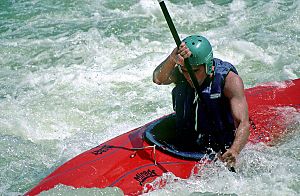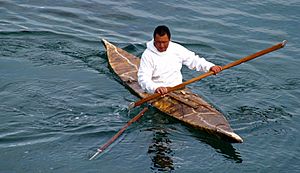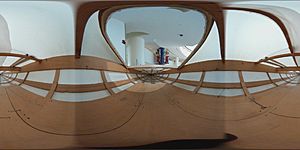Kayak facts for kids
A kayak is a small, narrow boat that you move through water using a paddle with two blades. The word "kayak" comes from the Greenlandic word qajaq.
Traditional kayaks have a covered top and one or more openings called cockpits. Each cockpit usually seats one person, called a paddler. Sometimes, a special cover called a spray deck is used over the cockpit. This keeps water from waves or splashes out of the boat.
The spray deck also lets skilled kayakers do something cool called an Eskimo Roll. This means they can flip the kayak upside down and then right it again without getting water inside or falling out!
What is a Kayak?
Kayaks are different from canoes. Kayaks use a double-bladed paddle, and you usually sit with your legs stretched out in front of you. Canoes often use a single-bladed paddle, and paddlers might kneel. Even though they are different, some modern canoes can look a lot like kayaks! In places like Great Britain and Ireland, people sometimes call kayaks "canoes."
History of Kayaks
The first kayaks were made and used by indigenous people in cold, northern parts of the world. These groups included the Aleut, Inuit, Yupik, and possibly the Ainu people. They used kayaks mainly for hunting seals and other animals in the water.
Modern Kayaks
Today, kayaks come in many different designs. Some modern kayaks are very different from the traditional ones:
- Sit-on-top kayaks: Instead of sitting inside a cockpit, you sit on top of the boat.
- Inflatable kayaks: These are made of air chambers that you inflate, making them easy to transport.
- Twin-hull kayaks: These have two hulls (bottom parts) instead of one, which can make them more stable.
People also use different ways to move kayaks now. While paddles are still common, some kayaks use foot pedals that power propellers or "flippers." You can even find kayaks with small electric motors or gasoline engines! Some people even sail their kayaks.
Images for kids
-
Kayaks are often used to get closer to marine animals, such as sea otters
-
Kayaking in the Upsala Glacier in Los Glaciares National Park
-
Two people in a kayak, Nunivak, Alaska, photographed by Edward S. Curtis, 1930
-
The world cup competitions in kayaking in Vaxholm, Sweden, photographed by Gunnar Lundh in 1938.
-
Child using oversized equipment. The kayak is floating too high, it is too wide for his hips and shoulders, and it is so deep that his elbows hit the deck. His paddle is also too long. It is impossible for him to paddle efficiently, and he will tire quickly. His PFD is also large enough to slip off over his head while fastened.
-
Kayaking in a double on Lake Union in Seattle, Washington, United States
-
Surf Kayaking competition, Tofino, British Columbia
See also
 In Spanish: Kayak para niños
In Spanish: Kayak para niños

































